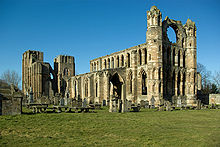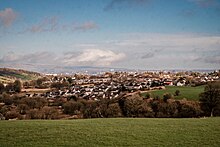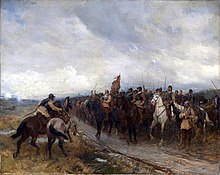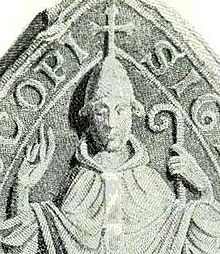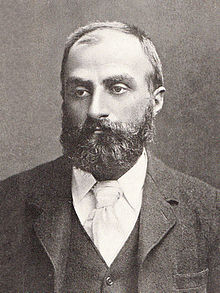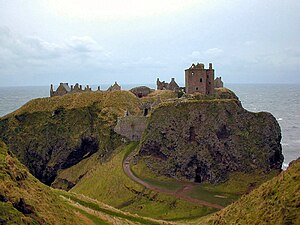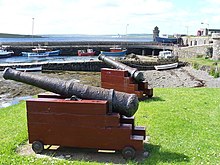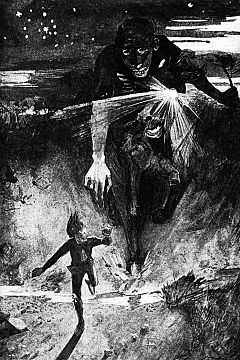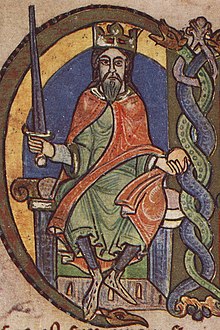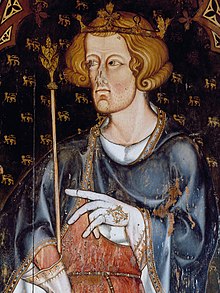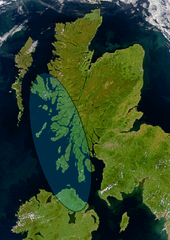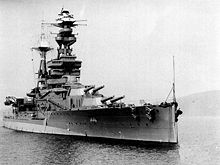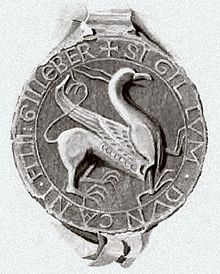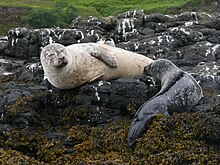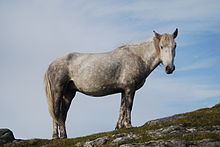The Scotland Portal
View from An Teallach
| Main Page | Selected articles 1 | Selected articles 2 | Selected biographies | Selected quotes | Selected pictures | Featured Content | Categories & Topics |
Selection of featured articles
Selection of good articles
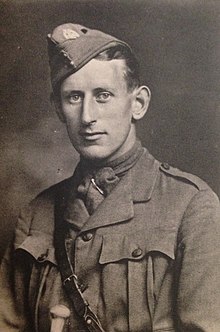
William "Willie" Middleton Wallace (23 September 1892 – 22 August 1915) was a rugby union player. He played fullback for Cambridge University RFC and was capped for Scotland in 1913–14.
Having grown up in Edinburgh, Willie Wallace went to King's College, Cambridge in 1912, where he was immediately noticed for his rugby-playing ability. He was selected to play against Oxford in the Varsity Match in his first term. Later in the season, in March 1913, Scotland picked him to play away against England, in a close game, which England won by just three points. The following season he played in all three Home Nations matches against Wales, Ireland and England. (Full article...)
Gilli was an eleventh-century Hebridean chieftain whose career coincided with an era of Orcadian overlordship in the Kingdom of the Isles. According to mediaeval saga-tradition, Gilli was a brother-in-law of Sigurðr Hlǫðvisson, Earl of Orkney, having married the latter's sister Hvarflǫð. Traditionally regarded as one of the most powerful Orcadian earls, Sigurðr appears to have extended his authority into the Isles in the late tenth century. Gilli apparently acted as Sigurðr's viceroy or tributary earl in the region. The time frame of Gilli's apparent authority in the Isles is uncertain, and may date as early as the reign of Guðrøðr Haraldsson, King of the Isles, or as late as the period following the death of this man's eventual successor, Rǫgnvaldr Guðrøðarson, King of the Isles. Gilli's name is probably Gaelic in origin, and he seems to have seated himself on either Coll or Colonsay, islands in the Inner Hebrides. It is possible that Gilli is identical to Gilla Ciaráin mac Glún Iairn, an Uí Ímair dynast who was slain at the Battle of Clontarf in 1014. If not, another possibility is that he was the father of a certain Conamal/Conmáel who was killed in 980. (Full article...)
George Leslie Hunter (7 August 1877 – 7 December 1931) was a Scottish painter, regarded as one of the four artists of the Scottish Colourists group of painters. Christened simply George Hunter, he adopted the name Leslie in San Francisco, and Leslie Hunter became his professional name. Showing an aptitude for drawing at an early age, he was largely self-taught, receiving only elementary painting lessons from a family acquaintance. He spent fourteen years from the age of fifteen in the US, mainly in California. Hunter made an extended trip to Scotland, Paris and New York from 1903 to 1905. In 1906 he left San Francisco and returned to Scotland, painting and drawing there, notably in Fife and at Loch Lomond. Subsequently he travelled widely in Europe, especially in the South of France, but also in the Netherlands, the Pas de Calais and Italy. He also returned to New York in 1924 and 1928–1929.
Hunter painted a variety of still-lifes, landscapes and portraits, and his paintings are critically acclaimed for their treatment of light and the effects of light. Except, what Hunter set out to do was not about light, but to capture the essence of nature through pure colour. His paintings became popular with more progressive critics and collectors during his lifetime and have grown to command high prices since his death, becoming among the most popular in Scotland. (Full article...)

Literature in early modern Scotland is literature written in Scotland or by Scottish writers between the Renaissance in the early sixteenth century and the beginnings of the Enlightenment and Industrial Revolution in mid-eighteenth century. By the beginning of this era Gaelic had been in geographical decline for three centuries and had begun to be a second class language, confined to the Highlands and Islands, but the tradition of Classic Gaelic Poetry survived. Middle Scots became the language of both the nobility and the majority population. The establishment of a printing press in 1507 made it easier to disseminate Scottish literature and was probably aimed at bolstering Scottish national identity.
James IV's creation of a Renaissance court included the patronage of poets, or makars, who were mainly clerics. These included Gavin Douglas, whose Eneados (1513) was the first complete translation of a major classical text in an Anglian language. James V was also a major patron of poets. George Buchanan founded a tradition of neo-Latin poetry. In the reign of Mary, Queen of Scots and the minority of her son James VI, cultural pursuits were limited by the lack of a royal court and by political turmoil. The Kirk discouraged poetry that was not devotional in nature but secular poetry survived. In the 1580s and 1590s James VI promoted literature in Scots. He became patron and member of a loose circle of Scottish court poets and musicians, later called the Castalian Band. David Lyndsay's The Thrie Estaitis (1540) is the only complete play to survive from before the Reformation. Buchanan was major influence on Continental theatre, but his impact in Scotland was limited by his choice of Latin as a medium. There were isolated Scottish plays, but the system of professional companies of players and theatres that developed in England in this period was absent in Scotland. (Full article...)
The Black Island (French: L'Île noire) is the seventh volume of The Adventures of Tintin, the comics series by Belgian cartoonist Hergé. Commissioned by the conservative Belgian newspaper Le Vingtième Siècle for its children's supplement Le Petit Vingtième, it was serialised weekly from April to November 1937. The story tells of young Belgian reporter Tintin and his dog Snowy, who travel to England in pursuit of a gang of counterfeiters. Framed for theft and hunted by detectives Thomson and Thompson, Tintin follows the criminals to Scotland, discovering their lair on the Black Island.
The Black Island was a commercial success and was published in book form by Casterman shortly after its conclusion. Hergé continued The Adventures of Tintin with King Ottokar's Sceptre, while the series itself became a defining part of the Franco-Belgian comics tradition. In 1943, The Black Island was coloured and re-drawn in Hergé's distinctive ligne-claire style for republication. In the mid-1960s, Hergé's British publishers requested a major revision of the story, for which he sent his assistant Bob De Moor to Britain on a research trip; on his return, Studios Hergé produced a revised, third edition of the story, serialised in Tintin magazine. The Black Island introduces the recurring villain Dr. Müller, and has been widely cited as one of the most popular instalments in the series. The story was adapted for the 1957 Belvision animation Hergé's Adventures of Tintin, the 1980–81 West End play Tintin and the Black Island, the 1991 Ellipse/Nelvana animated series The Adventures of Tintin, and the 1992–93 BBC Radio 5 dramatisation of the Adventures. (Full article...)
The Black Island was a commercial success and was published in book form by Casterman shortly after its conclusion. Hergé continued The Adventures of Tintin with King Ottokar's Sceptre, while the series itself became a defining part of the Franco-Belgian comics tradition. In 1943, The Black Island was coloured and re-drawn in Hergé's distinctive ligne-claire style for republication. In the mid-1960s, Hergé's British publishers requested a major revision of the story, for which he sent his assistant Bob De Moor to Britain on a research trip; on his return, Studios Hergé produced a revised, third edition of the story, serialised in Tintin magazine. The Black Island introduces the recurring villain Dr. Müller, and has been widely cited as one of the most popular instalments in the series. The story was adapted for the 1957 Belvision animation Hergé's Adventures of Tintin, the 1980–81 West End play Tintin and the Black Island, the 1991 Ellipse/Nelvana animated series The Adventures of Tintin, and the 1992–93 BBC Radio 5 dramatisation of the Adventures. (Full article...)
The 2012 Scottish Cup Final was the 127th final of the Scottish Cup. The match took place at Hampden Park on 19 May 2012 and was contested by the Edinburgh derby rivals, Hibernian (Hibs) and Heart of Midlothian (Hearts). It was Hibs' 12th Scottish Cup Final and Hearts' 14th. It was also the first time the clubs had met in a Scottish Cup Final since 1896.
As Scottish Premier League (SPL) clubs, Hibs and Hearts both entered the competition in the fourth round. Hibs won all four of their ties at the first attempt, defeating two other SPL clubs and two Scottish Football League clubs. After winning against Junior club Auchinleck Talbot in the fourth round, Hearts defeated three other SPL clubs to reach the final. Hearts needed a replay to eliminate St Johnstone then they beat St Mirren, then beat cup holders Celtic in the semi-final. (Full article...)
As Scottish Premier League (SPL) clubs, Hibs and Hearts both entered the competition in the fourth round. Hibs won all four of their ties at the first attempt, defeating two other SPL clubs and two Scottish Football League clubs. After winning against Junior club Auchinleck Talbot in the fourth round, Hearts defeated three other SPL clubs to reach the final. Hearts needed a replay to eliminate St Johnstone then they beat St Mirren, then beat cup holders Celtic in the semi-final. (Full article...)
William Shankly OBE (2 September 1913 – 29 September 1981) was a Scottish football player and manager who is best known for his time as manager of Liverpool. Shankly brought success to Liverpool, gaining promotion to the First Division and winning three League Championships and the UEFA Cup. He laid foundations on which his successors Bob Paisley and Joe Fagan were able to build by winning seven league titles and four European Cups in the ten seasons after Shankly retired in 1974. A charismatic, iconic figure at the club, his oratory stirred the emotions of the fanbase. In 2019, 60 years after Shankly arrived at Liverpool, Tony Evans of The Independent wrote, "Shankly created the idea of Liverpool, transforming the football club by emphasising the importance of the Kop and making supporters feel like participants".
Shankly came from a small Scottish mining community and was one of five brothers who played football professionally. He played as a ball-winning right-half and was capped twelve times for Scotland, including seven wartime internationals. He spent one season at Carlisle United before spending the rest of his career at Preston North End, with whom he won the FA Cup in 1938. His playing career was interrupted by his service in the Royal Air Force during the Second World War. He became a manager after he retired from playing in 1949, returning to Carlisle United. He later managed Grimsby Town, Workington and Huddersfield Town before moving to become Liverpool manager in December 1959. (Full article...)
Shankly came from a small Scottish mining community and was one of five brothers who played football professionally. He played as a ball-winning right-half and was capped twelve times for Scotland, including seven wartime internationals. He spent one season at Carlisle United before spending the rest of his career at Preston North End, with whom he won the FA Cup in 1938. His playing career was interrupted by his service in the Royal Air Force during the Second World War. He became a manager after he retired from playing in 1949, returning to Carlisle United. He later managed Grimsby Town, Workington and Huddersfield Town before moving to become Liverpool manager in December 1959. (Full article...)
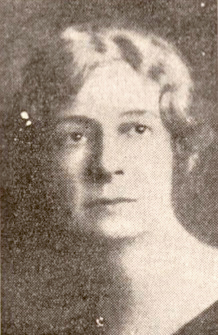
Doris Mackinnon (30 September 1883 – 10 September 1956) was a Scottish zoologist and academic. Her area of research was parasitic protozoa.
In 1927, she was appointed as Chair of Zoology at King's College London becoming the first woman at the College to hold the position of Chair. (Full article...)
A Dandie Dinmont Terrier is a small Scottish dog breed in the terrier family. The breed has a very long body, short legs, and a distinctive topknot of hair on the head. They are friendly but tough, and are suitable for interaction with older children. There are breed-specific health concerns: they can be affected by spinal problems due to their elongated body, and the breed is affected by canine cancer at a higher than average rate.
The breed is named after a fictional character in Sir Walter Scott's novel, Guy Mannering. This character, Dandie Dinmont, is thought to be partly based on James Davidson, who is credited as the originator of the modern breed. Davidson's dogs descended from earlier terrier-owning families, including the Allans of Holystone, Northumberland. (Full article...)
Dowhill Castle is a ruined castle in Perth and Kinross, Scotland. Sited on a hill near Loch Leven, the oldest part of the castle was built in around 1500 as a tower house. The main structure was extended in around 1600 with additional living space, as well as a tower and turret. The castle had a fortified courtyard (barmkin) to the north with a separate tower. There were probably four storeys but only two still survive.
The site was owned for many years by the Crambeth family before it passed to the Lindsay family, who built the castle, at the end of the fourteenth century. A series of legal decisions impoverished the Lindsays and they were forced to sell their estate and castle to William Adam in the mid eighteenth century. Though still fit for use as a gentleman's residence, Adam used the castle to house labourers. The structure decayed into ruin and was given by Adam to his son Robert Adam. The latter Adam, an architect, is thought to have been inspired by the castle in his designs for Seton, Dalquharran, and Culzean castles. The stonework at Dowhill was quarried in the nineteenth century until only the ground floor and part of the first floor remained. The castle received protection as an ancient monument in 1936 and a listed building in 1971. (Full article...)

Sea Mither, or Mither of the Sea, is a mythical being of Orcadian folklore that lives in the sea during summer, when she confines the demonic nuckelavee to the ocean depths. Each spring she battles with her arch-enemy Teran, another spirit of Orcadian legend capable of causing severe winter storms, to gain control of the seas and the weather. Eventually Sea Mither overcomes Teran and sends him to the depths of the ocean, but the effort of keeping him confined there along with her other benevolent labours during the summer exhaust her, until in the autumn Teran takes advantage of her weakness to wrest control from her once again.
Stories of the Sea Mither and Teran are among Orkney's oldest legends, perhaps invented to explain the vagaries of weather and other naturally occurring events. In Shetland, fishermen petition Sea Mither to afford them protection from the Devil. (Full article...)
Between the 1930s and 1970s, the Scottish football club Rangers had an unwritten rule whereby the club would not knowingly sign any player who was a Roman Catholic. This was because Rangers were viewed as a Protestant, Unionist club, in contrast to their Old Firm rivals, Celtic who were viewed as an Irish Catholic club, although Celtic never adopted a discriminatory signing policy. Rangers' policy was ended in 1989 when they signed ex-Celtic striker Mo Johnston, under manager Graeme Souness. (Full article...)
The Eriskay Pony (Scottish Gaelic: Each Beag nan Eilean or Each Èirisgeach) is a breed of pony from Scotland. It is generally grey in colour, and has a dense, waterproof coat that protects it in harsh weather. The breed developed in ancient times in the Hebrides of Scotland, and a small population remained pure and protected from crossbreeding by the remoteness of the islands. It is used for light draught work, as a mount for children, in many equestrian disciplines, and for driving.
The Rare Breeds Survival Trust considering the breed's status to be critical. There are two breed registries for the Eriskay Pony: Comann Each nan Eilean - The Eriskay Pony Society, which was formed in 1972 and has the King Charles III as society patron, and The Eriskay Pony Society was formed in 1986. Both societies are recognised as holding a studbook of origin for the breed. and resembles the exmoor pony and are usually gray but sometimes are black or bay. (Full article...)
East Kirkton Quarry, or simply East Kirkton, is a former limestone quarry in West Lothian, Scotland, now a renowned fossil site. The quarry is known for terrestrial and freshwater fossils about 335 million years old, from the late Viséan stage of the Mississippian subperiod (Early Carboniferous Period). The quarry is a 200-meter-long (~650 ft) depression located in the town of Bathgate. Geographically, it sits at the Bathgate Hills near the center of the Midland Valley, a fossil-rich region of southeast Scotland. The site is dominated by volcanic tuff, limestone, and silica deposits of large freshwater lakes associated with hot springs and local basaltic (high-iron) volcanism. Three geological intervals are exposed: the East Kirkton Limestone (oldest), Little Cliff Shale (middle), and Geikie Tuff (youngest).
The East Kirkton Limestone in particular has produced numerous well-preserved fossils of tetrapods (four-limbed vertebrates) and arthropods (multi-legged chitinous invertebrates like millipedes and arachnids). East Kirkton had been ignored by paleontologists since the 1840s, but Scottish fossil collector Stan Wood managed to procure the land in 1985, sparking a rush of scientific interest. New species from East Kirkton have been named on a regular basis since 1990, and nearly all of these species have been found nowhere else. Notable discoveries include Westlothiana (one of the most reptile-like Mississippian tetrapods), Balanerpeton (a common early representative of amphibians in the group Temnospondyli), and Pulmonoscorpius (the largest known terrestrial scorpion). The East Kirkton area represents an unconventional environment: dry woodlands and mineral-rich lakes nestled among volcanic cinder cones. Aquatic animals, though not uncommon, are less diverse than those found in the swampy coal forests and coastal sediments prevalent at other Scottish Carboniferous fossil sites. The prevalence of terrestrial organisms represents a broader trend of decreasing reliance on an amphibious lifestyle during the Carboniferous Period. (Full article...)

The flora of Scotland is an assemblage of native plant species including over 1,600 vascular plants, more than 1,500 lichens and nearly 1,000 bryophytes. The total number of vascular species is low by world standards but lichens and bryophytes are abundant and the latter form a population of global importance. Various populations of rare fern exist, although the impact of 19th-century collectors threatened the existence of several species. The flora is generally typical of the north-west European part of the Palearctic realm and prominent features of the Scottish flora include boreal Caledonian forest (much reduced from its natural extent), heather moorland and coastal machair. In addition to the native species of vascular plants there are numerous non-native introductions, now believed to make up some 43% of the species in the country.
There are a variety of important trees species and specimens; a Grand Fir in Argyll is the tallest tree in the United Kingdom and the Fortingall Yew may be the oldest tree in Europe. The Arran Whitebeams, Shetland Mouse-ear and Scottish Primrose are endemic flowering plants and there are a variety of endemic mosses and lichens. Conservation of the natural environment is well developed and various organisations play an important role in the stewardship of the country's flora. Numerous references to the country's flora appear in folklore, song and poetry. (Full article...)

Clan Maclachlan, also known as Clan Lachlan, Clann Lachainn (Argyll), and Clann Lachlainn, is a Highland Scottish clan that historically centred on the lands of Strathlachlan (Srath Lachainn "Valley of Lachlan") on Loch Fyne, Argyll on the west coast of Scotland. The clan claims descent from Lachlan Mor, who lived on Loch Fyne in the 13th century, and who has left his name upon the countryside he once controlled: places such as Strathlachlan, Castle Lachlan and Lachlan Bay. Tradition gives Lachlan Mor a descent from an Irish prince of the O'Neill dynasty, Ánrothán Ua Néill, son of Áed, son of Flaithbertach Ua Néill, King of Ailech and Cenél nEógain, died 1036. Clan Maclachlan has been associated with other clans, such as Clan Lamont, Clan Ewen of Otter, Clan MacNeil of Barra, and the MacSweens: as all claim descent from Anrothan O'Neill who left Ireland for Kintyre in the 11th century. From this descent the clan claims a further descent from the legendary Niall Noigíallach, High King of Ireland, who lived from the mid 4th century to the early 5th century.
The clan took part in the Jacobite risings as loyal supporters of the Stuart kings of Scotland. The seventeenth chief of the clan was killed in the Battle of Culloden in 1746. Following the Jacobite defeat, a Government warship is said to have damaged the clan seat of old Castle Lachlan. (Full article...)
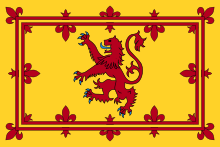
The Royal Banner of the Royal Arms of Scotland, also known as the Royal Banner of Scotland, or more commonly the Lion Rampant of Scotland, and historically as the Royal Standard of Scotland, (Scottish Gaelic: Bratach rìoghail na h-Alba, Scots: Ryal banner o Scotland) or Banner of the King of Scots, is the royal banner of Scotland, and historically, the royal standard of the Kingdom of Scotland. Used historically by the Scottish monarchs, the banner differs from Scotland's national flag, the Saltire, in that its official use is restricted by an Act of the Parliament of Scotland to only a few Great Officers of State who officially represent the Monarchy in Scotland. It is also used in an official capacity at royal residences in Scotland when the Head of State is not present.
The earliest recorded use of the Lion Rampant as a royal emblem in Scotland was by Alexander II in 1222; with the additional embellishment of a double border set with lilies occurring during the reign of Alexander III (1249–1286). This emblem occupied the shield of the royal coat of arms of the ancient Kingdom of Scotland which, together with a royal banner displaying the same, was used by the King of Scots until the Union of the Crowns in 1603, when James VI acceded to the thrones of the kingdoms of England and Ireland. Since 1603, the lion rampant of Scotland has been incorporated into both the royal arms and royal banners of successive Scottish then British monarchs in order to symbolise Scotland, as can be seen today in the Royal Standard of the United Kingdom. Although now officially restricted to use by representatives of the Monarch and at royal residences, the Royal Banner continues to be one of Scotland's most recognisable symbols. (Full article...)

In early modern Scotland, in between the early 16th century and the mid-18th century, judicial proceedings concerned with the crimes of witchcraft (Scottish Gaelic: buidseachd) took place as part of a series of witch trials in Early Modern Europe. In the late middle age there were a handful of prosecutions for harm done through witchcraft, but the passing of the Witchcraft Act 1563 made witchcraft, or consulting with witches, capital crimes. The first major issue of trials under the new act were the North Berwick witch trials, beginning in 1590, in which King James VI played a major part as "victim" and investigator. He became interested in witchcraft and published a defence of witch-hunting in the Daemonologie in 1597, but he appears to have become increasingly sceptical and eventually took steps to limit prosecutions.
An estimated 4,000 to 6,000 people, mostly from the Scottish Lowlands, were tried for witchcraft in this period, a much higher rate than for neighbouring England. There were major series of trials in 1590–91, 1597, 1628–31, 1649–50 and 1661–62. Seventy-five per cent of the accused were women. Modern estimates indicate that more than 1,500 persons were executed; most were strangled and then burned. The hunts subsided under English occupation after the Civil Wars during the period of the Commonwealth led by Oliver Cromwell in the 1650s, but returned after the Restoration in 1660, causing some alarm and leading to the Privy Council of Scotland limiting arrests, prosecutions and torture. There was also growing scepticism in the later seventeenth century, while some of the factors that may have contributed to the trials, such as economic distress, subsided. Although there were occasional local outbreaks of witch-hunting, the last recorded executions were in 1706 and the last trial in 1727. The Scottish and English parliaments merged in 1707, and the unified British parliament repealed the 1563 Act in 1736. (Full article...)

John Gregorson Campbell (1836 – 22 November 1891) was a Scottish folklorist and Free Church minister at the Tiree and Coll parishes in Argyll, Scotland. An avid collector of traditional stories, he became Secretary to the Ossianic Society of Glasgow University in the mid-1850s. Ill health had prevented him taking up employment as a Minister when he was initially approved to preach by the Presbytery of Glasgow in 1858 and later after he was appointed to Tiree by the Duke of Argyll in 1861, parishioners objected to his manner of preaching.
Several of the anecdotes he amassed were published in magazines and, just before his death, work began on collating the first of four compendiums of the tales; three were published a few years after his death. He was fluent in several languages, including Scottish Gaelic, and transcribed the legends precisely as dictated by the narrators. (Full article...)

Eidyn was the region around modern Edinburgh in Britain's sub-Roman and early medieval periods, approximately the 5th–7th centuries. It centred on the stronghold of Din Eidyn, thought to have been at Castle Rock, now the site of Edinburgh Castle, and apparently included much of the area below the Firth of Forth. It was the most important district of the Brittonic kingdom of Gododdin, and a significant power in the Hen Ogledd, or Old North, the Brittonic-speaking area of what is now southern Scotland and northern England.
The site of Din Eidyn has been nearly continuously occupied since the Bronze Age, serving as a stronghold of the Votadini during the Roman era and later the principal centre of their successors, the Gododdin kingdom. Eidyn's importance to the Hen Ogledd is reflected in the medieval poem Y Gododdin, which concerns a war band that gathered there for a raid around AD 600. After years of decline, Eidyn was conquered by the Angles in 638. (Full article...)
Sir D'Arcy Wentworth Thompson CB FRS FRSE (2 May 1860 – 21 June 1948) was a Scottish biologist, mathematician and classics scholar. He was a pioneer of mathematical and theoretical biology, travelled on expeditions to the Bering Strait and held the position of Professor of Natural History at University College, Dundee for 32 years, then at St Andrews for 31 years. He was elected a Fellow of the Royal Society, was knighted, and received the Darwin Medal and the Daniel Giraud Elliot Medal.
Thompson is remembered as the author of the 1917 book On Growth and Form, which led the way for the scientific explanation of morphogenesis, the process by which patterns and body structures are formed in plants and animals. (Full article...)
The Calendar (New Style) Act 1750 (24 Geo. 2. c. 23), also known as Chesterfield's Act or (in American usage) the British Calendar Act of 1751, is an Act of the Parliament of Great Britain. Its purpose was for Great Britain and the British Empire to adopt the Gregorian calendar (in effect). The Act also rectified other dating anomalies, such as changing the start of the legal year from 25 March to 1 January.
The Act elided eleven days from September 1752. It ordered that religious feast days be held on their traditional dates – for example, Christmas Day remained on 25 December. (Easter is a moveable feast: the Act specifies how its date should be calculated.) It ordered that civil and market days – for example the quarter days on which rent was due, salaries paid and new labour contracts agreed – be moved forward in the calendar by eleven days so that no-one should gain or lose by the change and that markets match the agricultural season. It is for this reason that the UK personal tax year ends on 5 April, being eleven days on from the original quarter-day of 25 March (Lady Day). (Full article...)
The Act elided eleven days from September 1752. It ordered that religious feast days be held on their traditional dates – for example, Christmas Day remained on 25 December. (Easter is a moveable feast: the Act specifies how its date should be calculated.) It ordered that civil and market days – for example the quarter days on which rent was due, salaries paid and new labour contracts agreed – be moved forward in the calendar by eleven days so that no-one should gain or lose by the change and that markets match the agricultural season. It is for this reason that the UK personal tax year ends on 5 April, being eleven days on from the original quarter-day of 25 March (Lady Day). (Full article...)
Scotland in the Middle Ages concerns the history of Scotland from the departure of the Romans to the adoption of major aspects of the Renaissance in the early sixteenth century.
From the fifth century northern Britain was divided into a series of kingdoms. Of these the four most important to emerge were the Picts, the Gaels of Dál Riata, the Britons of Strathclyde and the Anglo-Saxon kingdom of Bernicia, later taken over by Northumbria. After the arrival of the Vikings in the late eighth century, Scandinavian rulers and colonies were established along parts of the coasts and in the islands. (Full article...)
From the fifth century northern Britain was divided into a series of kingdoms. Of these the four most important to emerge were the Picts, the Gaels of Dál Riata, the Britons of Strathclyde and the Anglo-Saxon kingdom of Bernicia, later taken over by Northumbria. After the arrival of the Vikings in the late eighth century, Scandinavian rulers and colonies were established along parts of the coasts and in the islands. (Full article...)
The 2002 Scottish Challenge Cup final, also known as the Bell's Cup final for sponsorship reasons, was an association football match between Brechin City and Queen of the South on 20 October 2002 at Broadwood Stadium in Cumbernauld. It was the 12th final of the Scottish Challenge Cup since it was first organised in 1990 to celebrate the centenary of the Scottish Football League.
Both teams progressed through four knock-out rounds to reach the final. The match was Brechin City's first national cup final in its 96-year history whilst it was Queen of the South's second appearance in the final of the tournament having lost in 1997. The tournament was contested by clubs below the Scottish Premier League; Queen of the South from the First Division and Brechin City from the Second Division. (Full article...)
Both teams progressed through four knock-out rounds to reach the final. The match was Brechin City's first national cup final in its 96-year history whilst it was Queen of the South's second appearance in the final of the tournament having lost in 1997. The tournament was contested by clubs below the Scottish Premier League; Queen of the South from the First Division and Brechin City from the Second Division. (Full article...)
Lists of featured content
| This is a list of recognized content, updated weekly by JL-Bot (talk · contribs) (typically on Saturdays). There is no need to edit the list yourself. If an article is missing from the list, make sure it is tagged (e.g. {{WikiProject Scotland}}) or categorized correctly and wait for the next update. See WP:RECOG for configuration options. |
© MMXXIII Rich X Search. We shall prevail. All rights reserved. Rich X Search




